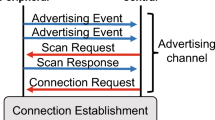Abstract
A novel technique is proposed to optimize energy efficiency for wireless networks based on hierarchical mobile clustering. The new bi-level clustering technique minimizes mutual interference and energy consumption in large-scale tracking systems used in large public gatherings such as festivals and sports events. This technique tracks random movements of a large number of people in a bounded area by using a combination of smart-phone Bluetooth and Wi-Fi connections. It can be effectively used for monitoring health conditions of crowd members and providing their locations and movement directions. An integer linear programming (ILP) model of the problem is formulated to optimize the formation of clusters in a two-level hierarchical structure. In order to evaluate the proposed technique, it is compared to the optimum solutions obtained from the ILP model for both single-level and two-level clustering. Moreover, a Matlab/Simulink simulation model is developed and used to test the technique’s performance under realistic operating conditions. The results demonstrate a very good performance of the proposed technique.














Similar content being viewed by others
References
Pathak, S., & Jain, S. (2016). A novel weight based clustering algorithm for routing in MANET. Wireless Networks,22(8), 2695–2704.
Osman, M. M. A., Syed-Yusof, S. K., Malik, N. N. N. A., & Zubair, S. (2018). A survey of clustering algorithms for cognitive radio ad hoc networks. Wireless Networks,24(5), 1451–1475.
Bluetooth SIG. (2017). Bluetooth specifications. Bluetooth Technology Website. https://www.bluetooth.com. Retrieved August 2017.
Abbasi, A. A., & Younis, M. (2007). A survey on clustering algorithms for wireless sensor networks. Computer Communications,30(14–15), 2826–2841.
Bandyopadhyay, S., & Coyle, E. J. (2003). An energy efficient hierarchical clustering algorithm for wireless sensor networks. In Twenty-second annual joint conference of the IEEE computer and communications societies (INFOCOM 2003) (Vol. 3, pp. 1713–1723). IEEE.
Yoo, J. W., & Park, K. H. (2011). A cooperative clustering protocol for energy saving of mobile devices with WLAN and Bluetooth interfaces. IEEE Transactions on Mobile Computing,10(4), 491–504.
Teng, J., Snoussi, H., & Richard, C. (2011). Collaborative multi-target tracking in wireless sensor networks. International Journal of Systems Science,42(9), 1427–1443.
Leem, H., Jung, B. H., & Sung, D. K. (2011). Cooperative MS-grouping schemes based on three cost metrics for improving battery lifetime and energy efficiency. In IEEE 22nd international symposium on personal indoor and mobile radio communications (pp. 899–903). IEEE.
Al-Kanj, L., Dawy, Z., & Yaacoub, E. (2013). Energy-aware cooperative content distribution over wireless networks: Design alternatives and implementation aspects. IEEE Communications Surveys and Tutorials,15(4), 1736–1760.
Al-Kanj, L., & Dawy, Z. (2013). Impact of network parameters on the design of energy-aware cooperative content distribution protocols. Transactions on Emerging Telecommunications Technologies,24(3), 317–330.
Baranidharan, B., & Santhi, B. (2016). DUCF: Distributed load balancing unequal clustering in wireless sensor networks using fuzzy approach. Applied Soft Computing,40, 495–506.
Oren, G., Barenboim, L., & Levin, H. (2017). Adaptive distributed hierarchical sensing algorithm for reduction of wireless sensor network cluster-heads energy consumption. In 13th International wireless communications and mobile computing conference (pp. 980–986). IEEE.
Xu, Y., Ding, O., Qu, R., & Li, K. (2018). Hybrid multi-objective evolutionary algorithms based on decomposition for wireless sensor network coverage optimization. Applied Soft Computing,68, 268–282.
Oh, H., Lee, J., & Choi, J. K. (2013). Energy-efficient dynamic load distribution for heterogeneous access networks. In International conference on ICT convergence (pp. 18–23). IEEE.
Farrag, M., Abo-Zahhad, M., Doss, M. M., & Fayez, J. V. (2017). A new localization technique for wireless sensor networks using social network analysis. Arabian Journal for Science and Engineering,42(7), 2817–2827.
Liu, X., Jia, M., Zhang, X., & Lu, W. (2018). A novel multi-channel internet of things based on dynamic spectrum sharing in 5G communication. IEEE Internet of Things Journal. https://doi.org/10.1109/JIOT.2018.2847731.
GAMS Software GmbH. (2018). GAMS specifications. GAMS Website https://www.gams.com. Retrieved April 2018.
Golmie, N., Van Dyck, R. E., Soltanian, A., Tonnerre, A., & Rebala, O. (2003). Interference evaluation of Bluetooth and IEEE 802.11 b systems. Wireless Networks,9(3), 201–211.
Song, M., Shetty, S., & Gopalpet, D. (2007). Coexistence of IEEE 802.11 b and Bluetooth: An integrated performance analysis. Mobile Networks and Applications,12(5), 450–459.
Cho, D. K., Lee, S. H., Chang, A., Massey, T., Chang, C. W., Tsai, M. H., et al. (2008). Opportunistic medical monitoring using Bluetooth P2P networks. In International symposium on world of wireless, mobile and multimedia networks (pp. 1–6). IEEE.
Mathew, A., Chandrababu, N., Elleithy, K., & Rizvi, S. (2009). IEEE 802.11 & Bluetooth interference: Simulation and coexistence. In Seventh annual communication networks and services research conference (pp. 217–223). IEEE.
Kamerman, A. (2000). Coexistence between Bluetooth and IEEE 802.11 CCK: Solutions to avoid mutual interference. IEEE P802.11 Working group contribution, IEEE 802.11-00/162.
Acknowledgements
The authors Uthman Baroudi and Abdulrahman Abu Elkhail would like to acknowledge the support provided by the Deanship of Scientific Research (DSR) at King Fahd University of Petroleum and Minerals, under the Grant RG1424-1.
Author information
Authors and Affiliations
Corresponding author
Additional information
Publisher's Note
Springer Nature remains neutral with regard to jurisdictional claims in published maps and institutional affiliations.
Rights and permissions
About this article
Cite this article
Baroudi, U., Abu Elkhail, A. & Alfares, H. Optimum bi-level hierarchical clustering for wireless mobile tracking systems. Wireless Netw 26, 1227–1242 (2020). https://doi.org/10.1007/s11276-019-02143-y
Published:
Issue Date:
DOI: https://doi.org/10.1007/s11276-019-02143-y




